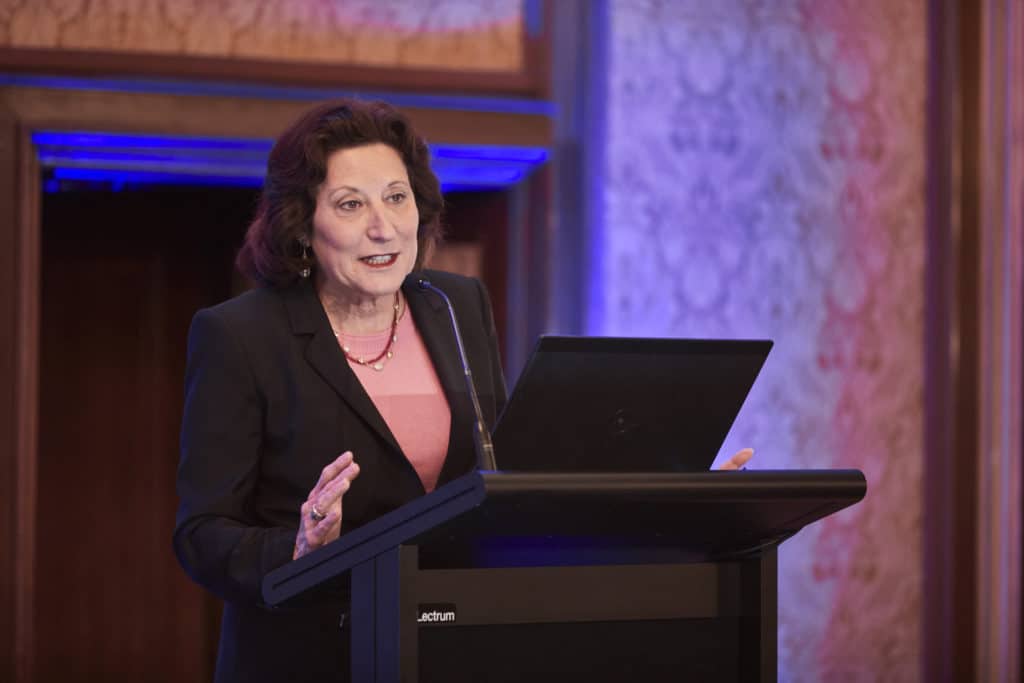New Options in HR+ Breast Cancer
“I really had fun putting together that talk and really talked about the natural history of metastatic HR+ breast cancer. It’s the most common subset in the most common cancer diagnosed in women worldwide, and our standards of care are sequential endocrine Therapy now with targeted agents.”
“We’ve made enormous advances with CDK4/6 inhibitors, with inhibitors of the PI3K pathway where many new agents are being tested. And now we have these oral selective oestrogen receptor down regulators on the horizon. But all patients will eventually develop resistance to endocrine therapy and go on to sequential single agent chemotherapy, and I think there’s concern as the CDK4/6 inhibitors move into the adjuvant setting that we will start seeing that sooner in the patients who are unfortunate enough to have endocrine resistance sooner.”
“So single agent sequential chemotherapy has the problem with lower response rates sequentially and also cumulative toxicity which really limits treatment in particular neuropathy and of course fatigue, which is part and parcel of all of our treatments. So, antibody drug conjugates are really exciting because this is a novel way, and apparently even more effective than we could’ve imagined, to deliver toxins to the cancer cell.”
“The antibody drug conjugates that are now the second plus generation have better linkers that are digested more easily in the cancer cell. And also, they have hydrophilic toxins that can leak out of the cell and kill nearby cells, that maybe don’t express the antigen on the cell surface that the antibody is targeted to as highly, but the toxins still kill the neighbouring cells.”
“So that’s called the bystander effect. And it’s an important part of these newer ADC’s along with the other things I mentioned. Then of course you need a target and so, you know, one effective way of making an antibody drug conjugate is to use trastuzumab as the backbone, and we’ve certainly seen great success and continuing remarkable success in that area, even in tumours that aren’t strictly HER2+.”
Listen to the Podcast
Listen to our conversation with Dr Hope Rugo as she discusses her research on the topic: New Options in HR+ Breast Cancer – TROPICS-02 & Beyond.
The TROPICS-02 Study Results Presented at ASCO 2022
“But first in class, novel antibody drug conjugate, sacituzumab govitecan was the subject of the Tropics-02 study that was presented at ASCO and is now in press and that is a novel antibody directed against TROP-2. And TROP-2 is an antigen that’s on most breast cancer cells and is highly expressed certainly in triple negative and HR+ cancers as data has shown. And there’s some suggestion that expression has been associated with a worse outcome and potentially resistant, so it might be something you’d want to target.”
“Sacituzumab govitecan is an antibody drug conjugate with the antibody directed to TROP-2, and then the toxin is the active metabolite of irinotecan called SN-38. So, it allows you to deliver a small amount of drug that’s highly potent directly to the cancer cell.”
“Sacituzumab govitecan after showing efficacy in a large Phase One B/2 trial in triple negative disease, improved progression free and overall survival in the Phase Three ascent trial and triple negative breast cancer, with the primary toxic being neutropenia and to a lesser degree diarrhoea. And about 50% of patients use growth factors. And now sacituzumab is more broadly approved for the treatment of metastatic triple negative breast cancer, receiving at least one line of therapy in the metastatic setting.”
“And ASCENT was positive even though patients could have received any number of lines of treatment.”
“So, the same approach was used in Tropics-02. This trial capitalized on data from a Phase One B trial, in just 54 patients, where there was a response rate of 30% and a respectable progression-free survival in hormone refractory heavily pre-treated hormone receptor positive metastatic breast cancer.”
“So, Tropics-02 targeted the same population, required at least two lines of chemotherapy for metastatic disease, but not more than four. And randomized patients to receive sacituzumab govitecan versus chemotherapy of physician choice with the primary endpoint of progression free survival by blinded independent review. And then overall survival was a secondary endpoint along with our usual safety and patient reported outcomes and response rates.”
I think it’s a really exciting time. We’ve seen these really, I think practice changing results from Destiny-Breast04 and now from Tropics-02, where we’re hopeful that we’ll see a greater difference in survival over time. And we’re waiting for those data.”
The Design and Eligibility Criteria
“The statistical design was a hierarchical design. So, you had to have a statistical significance in each prior endpoint before you could do the next one with statistical significance. This meaning essentially that you had to have statistical significance in PFS to look at OS, and significance in OS to look at response and then patient reported outcomes. The hazard ratio that the trial was powered for was 0.7 with a two-sided P-value of 0.5. So the trial enrolled over 500 patients who had a median of three lines of prior chemotherapy for metastatic disease.”
“In order to be eligible for the trial you had to have received a CDK4/6 inhibitor and a taxane in any setting. And then these patients also you know had received a lot of prior chemotherapy, about 80% had received prior capecitabine. In the treatment of physician choice, about 50% received eribulin as the comparator chemotherapy. So, what we saw was that progression free survival was significantly prolonged in patients who received sacituzumab compared to the chemotherapy arm, and the hazard ratio was 0.66, so it exceeded our goal.”
“The median difference in PFS was 1.5 months, but the issue with looking at medians by Kaplan Meier calculation is that in the first two months, about 20% or more of the patients in both arms had progressive disease. Mainly because patients were very heavily pre-treated and had universal chemotherapy resistant disease. After that period of time, the curve separated, and stayed separated over time.”
“So, we looked at landmark analyses to try and help us understand the true benefit of sacituzumab of at 6, 9 and 12 months sacituzumab was superior to treatment of physician choice and notably at 12 months, there was a threefold improvement in the patients who are free from progression or death, who were treated with sacituzumab compared to those treated with the chemotherapy. So, it was 21 versus 7%.”
“Overall response was also increased. Although we could only do nominal P-values because the overall survival in this first interim analysis was not significantly better with sacituzumab. Numerically there was a longer overall survival but of course it really had no P-value of significance. There are three total planned analyses, and we hope to see the next analysis – the second interim analysis in the next year or shorter. It all depends on events.”
“So overall response, we looked at quality of life and global health status. Quality of life had a longer time to deterioration in patients receiving sacituzumab versus treatment of physician choice, as did fatigue. Pain was about the same and we will present more data on the quality of life at ESMO 2022.”
“So, we felt based on that data that sacituzumab govitecan was a new potential option for treatment, in patients with hormone receptor positive, heavily pre-treated metastatic breast cancer, based on all of this data.”
“We looked at safety because that’s an important consideration. And there were no new safety signals compared to the Phase Three ASCENT trial, which led to regulatory approval. Primarily neutropenia, and then to a lesser degree diarrhoea. And we also understood looking at the events in those patients that it’s very important to be proactive about treating the neutropenia with growth factors, delay in treatment, and dose reductions when appropriate, in order to avoid neutropenia complications.”
“The NCCN guidelines, so the National Comprehensive Cancer Network, updated their guidelines right after ASCO 2022 based on the data from Destiny-Breast04 that looked at trastuzumab deruxtecan in HER2-low disease 1+ or 2+ with the primary endpoint being in HR+ breast cancer. Just 58 patients had triple negative disease.”
“And then also based on Tropics-02, enlisted both as options for patients who have metastatic breast cancer who are on chemotherapy, was the eligibility or the suggested eligibility in the NCC and guidelines mirroring the trials. So heavily pre-treated HR+ disease for trastuzumab deruxtecan at least one line of prior chemotherapy and HER2-low disease confirmed by pathologic testing.”
“Our goal in being breast oncologists and studying novel therapies is to improve overall survival and quality of life. So, helping patients live as long as possible with the best quality of life in the metastatic setting.”
How will this Research Benefit Patients?
“The overarching goal is to prevent metastatic disease and to cure patients with early-stage breast cancer with the least toxicity. So, you want the least acute toxicity and you really want no, if possible, long term side effects from the treatment you’ve delivered. We know we can already improve outcome for triple negative disease by being giving checkpoint inhibitors. But we also know that immunotherapy can result in long term toxicity.”
“So, we’re willing to give up a little bit of that in order to cure more patients from a very high-risk fatal disease otherwise. So, what can antibody drug conjugates do for us? Well, I think they’ve already shown us that we can improve outcomes for patients with metastatic disease and across a number of different subsets. So, HER2+, triple negative, and HR+ disease, have all have shown benefit from treatment with antibody drug conjugate with really remarkable improvements and manageable toxicity to a large degree.”
“Now, what we’d like to see is move those drugs even earlier to the first line setting. I mentioned, you know in talking about these drugs, I’ve always mentioned that chemotherapy a lot of it causes cumulative toxicity. You know, there are drugs you just can’t keep giving because patients have neuropathy, and neuropathy is so miserable for patients. You know, you can’t wear your shoes, can’t hold things as well.”
“Well, these drugs, the ones that are now available and have regulatory approval don’t cause neuropathy, you have to monitor for the side effects. But the cumulative toxicity is relatively modest. So, patients could potentially stay on for a long time, then we’re going to have to think about ways to maintain that response. Maybe give the drugs less frequently or something like that, think of maintenance. But if we can move this into earlier lines of chemotherapy, we still are going to use endocrine therapy and targeted agents.”
Dr Rugo’s Hope for the Future
“You know, maybe we could really improve that duration of time that patients have disease control, when their cancers are endocrine resistant or importantly for triple negative disease, where the majority of patients, more than 50% don’t qualify for immunotherapy. And then again, the overarching goal is to prevent recurrence of disease.”
“I think there’s two different approaches in early-stage setting. One is to take patients whose cancers don’t respond to the standard therapy and rescue them with these antibody drug conjugates. But then I think the next step is to maybe use the antibody drug conjugates up front, so that we can potentially have even better responses with maybe less intensive therapy that doesn’t have the some of the risks that chemotherapy does.”
“So that’s the biggest picture, looking at the farthest ahead of where we may be in the next few years, as we continue to test these novel agents. And of course, there are new antibody drug conjugates being produced and tested, and so there’s a lot of room for even greater improvements and newer targets and newer toxins.
Support Us
Help us to change lives through breast cancer clinical trials research



